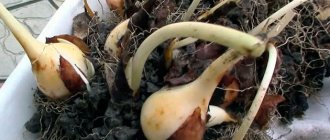Reasons for digging up tulip bulbs. The optimal time to dig them up and plant them back.
The beauty of summer garden plots is the merit of caring owners who are attentive to the nature and characteristics of plants. The latter often require periodic changes in their growing location. This has a beneficial effect on the health of plants, their beauty during the flowering period, and the preservation of appearance and color.
Interestingly, not all plants should be dug up for the winter. There are some that feel better after summer drying. For example, tulip bulbs. They don't particularly like soil moisture, and they have a lot of pests. Not only pathogenic, but also physically destroying their bulbs.
Why dig up tulip bulbs?
a person digs up tulip bulbs for storage.
The main reason is to preserve the appearance of flowers, their beauty and health.
Other important points:
- Reproduction. Since the main way to obtain new plants is through vegetation with bulbs, gardeners collect them and then grow them for 1-2 years.
- Preventing diseases. During the hot season, the maximum number of pests and pathogenic flora is present in the soil. Rainfall and increased soil moisture add to the problem.
- Selection of the best bulbs . When you go through the dug up bulbs with your hands, you see the affected specimens and discard them.
- Control of root depth. Tulip bulbs have the property of gradually going deeper into the soil. This is fraught with delayed flowering, thinning of the stem, shredding of the flower itself and a decrease in its vigor. In other words, the tulips will degenerate.
- Change of place. If you are planning construction work or redevelopment of the site, be sure to dig up tulips. Then for the winter you will find the best place for them to bloom next year.
How to store tulip bulbs before planting in the fall
After the bulbs have been dug up, they are shaken off the ground, placed in boxes and put away to dry. It is better to dry them under a canopy, in the attic, avoiding direct sunlight. Drying will take 1-2 weeks at a temperature of + 25-30 degrees, then the temperature can be reduced. The main storage conditions before planting in open ground in the fall are dryness and ventilation.
After that, dead roots are removed from the heads by hand, the remaining peduncle is cut off and the bulbs are sorted by size. Large specimens can be used for forcing. If you have a large number of large children, you can share them with friends or neighbors in the country.
Before planting before winter, the bulbs are stored in a cool, dry place in boxes or paper bags. An interesting idea for storing tulip bulbs is in egg containers.
Have a good harvest!
Tulips have bloomed: when and in what month should I dig up the bulbs after flowering?
dug up tulips after they have bloomed.
Professionals in the field of tulip breeding dig up their tubers immediately after the flower stalks wither. That is, at the end of May - beginning of June.
Land owners who do their own landscaping leave the bulbs until the end of June - beginning of July.
When to plant tulip bulbs after digging
The good thing about tulips is that their bulbs will be ready for planting in just a few months. For example, children can be seated in the second half of August and the first ten days of September. Adult bulbs are planted a little later, from September to November.
The main condition in this case is that the earth must have time to cool down to AT LEAST 10 degrees.
Why is it important? The fact is that tulips are considered one of the primroses, which means they begin to germinate in relatively cold soil.
It is also possible to plant plants in the spring, but in this case they will bloom much later.
The most experienced flower growers plant tulips literally 1.5-2 weeks before frost. But in this case, they carefully mulch the plantings and additionally cover everything with branches, leaves and even agrofibre.
When to dig up tulips in the summer for replanting and plant again?
tulip bulbs ready for storage
The best time to dig up is when the leaves have yellowed. However, do not wait until they die completely, otherwise it will be difficult to find plant bulbs later.
Consider the climatic conditions of the area in which you live. For some, digging in June is appropriate, for others - at the end of July.
Place dried tulip bulbs back into the soil in the fall. The ideal option is during the first frost on the ground. Although many gardeners prefer to do this either:
- for the first school bell
- during the period of planting garlic for the winter
Taking into account the climatic conditions of your area, planting tulip tubers is allowed even in November.
Do I need to dig up tulips every year or can I leave them for up to 3 years?
Olga, I agree with many of your conclusions, but I want to add some precision to your wording. For example, you write - “there are tulips that don’t need to be dug up at all, these are Kaufmann, Forster, Greig, botanical tulips, as well as Triumph, simple early and simple late and Darwinian hybrids.” I agree that Kaufmann, Forster, Greig and botanical tulips may not be dug up for some time. But all the same, they will become smaller over time (or rather, their bulbs will become smaller) and many of them will burrow deeper and deeper. The groups of tulips you listed are indeed the least susceptible to various diseases and are best preserved, because all of them are not very far removed from the botanical species. and in nature there is no one to dig them up and exfoliate them. But such tulips are not very popular among the population and their percentage in gardens is no more than 15%. Well, many Darwin hybrids can also be classified as rarely dug up tulips, especially old varieties, but not all of them. The selection of tulips is moving at such a pace that modern Darwin hybrids are not very resistant to various viral diseases and fusarium. There are many cases where such varieties were simply discontinued in Holland, precisely for this reason. But it is advisable to dig up Triumph tulips, simple early and simple late ones every year and let them bloom every other year, otherwise the same problem will occur - they will be crushed and stop blooming over time. If everything were as simple as you claim, then: a) in Holland and some other countries where they are now grown, they also would not have been dug up for years and crop rotation would not have been done at all. Let them grow for 5-6 years in one place until they bloom. But no, every time they are dug up and replanted, peeled and sorted, discarding diseased and infected bulbs. b) you have probably been to the famous Keukenhoff park. So, not only are all the bulbous plants dug up there every year, but in those places where tulips will grow, even all the soil is changed to the hilt of a shovel and taken completely outside the park! Because in the old soil (soil) fungal spores and various viral diseases from previous planting and even from their fellow bulbous plants, not necessarily tulips, can survive.
Further you write “for two weeks they are placed in a dark, ventilated place with a temperature of 20 - 25 degrees. And then, before planting, they are transferred to a dark, but cool place with good ventilation, the temperature should not be higher than 15 - 16 degrees. As a rule, this is a basement, so cardboard boxes can only be used at the beginning of “cold” storage. Subsequently, moisture may accumulate in the basement and the boxes will become damp. It’s better to bury the bulbs in river sand.”
How is that? And why only for two weeks? Have you ever wondered what will happen if you bury them in the basement or not in the basement in the sand? They'll just grow there! Especially if there is high humidity, as you write.
In fact, everything is completely different. The bulbs are dug up at the end of June - beginning of July, as soon as their leaves begin to turn yellow and dry out. Dig them up and dry them in a well-ventilated place, in the shade or partial shade, as long as the direct sun does not fall heavily on them and does not overheat the bulbs too much. Usually 2-3 dry days are enough, but sometimes this process drags on for a week, which is not scary. When the bulbs have dried thoroughly, they need to be peeled, sorted by variety and sorting, well, at least by variety, and placed in a well-ventilated container - ventilated mesh boxes, nets, etc. And it is advisable to store them at a temperature not lower than 20-25 degrees for about a month and a half. I understand that this temperature does not always happen outside and in the shade, but it’s not scary. It is at this temperature that in many species and varieties of tulips a full-fledged flower bud is formed in the bulbs, which will allow the bulb to bloom beautifully and fully in the next season. And that is why many growers did not have up to 40% of the buds of different varieties this year, because we didn’t have summer last year and it was very cold. And already from the end of August and in September it is really advisable to store them at temperatures no higher than 20 C, since at this time such temperatures basically maintain themselves. Short-term heating of the bulbs in the daytime to 25 C for a few hours will not particularly affect their flowering later. It is much more important to provide a small draft or ventilation during the entire storage period of the bulbs. The fact is that when there are a lot of bulbs, or there are a lot of fruits nearby (apples, pears, etc.), then they all begin to emit ethylene, which is detrimental to both the bulbs and the bud embryos and if the bulb is improperly or insufficiently ventilated You might just lose it next year. Well, as you all understand, in the ground temperatures like 20-25 degrees simply cannot be reached even in the summer, especially at night, even in the hottest months, unless we are talking about the hottest and driest years.
Further, during the growth process, covering scales naturally form between new bulbs, which also die off when the growing season ends, so it is advisable to remove them as much as possible during the process of drying and peeling the bulbs, leaving the strongest and most undamaged (brown) on the outside. It will protect the bulb from further drying out and from possible mechanical damage. If this is not done year after year, then it is precisely between the bulbs that various rots begin to develop and small worms like to hide there. They feel good there, warm, comfortable and humid, and there is something to eat. By the way, you've probably heard that in Holland, in those places where tulips are grown industrially, it is prohibited by law to grow potatoes in any form. Because there is a common pest - a nematode, which also loves tulips very much, and some varieties even more than potatoes, because they (potatoes) are watered with various chemicals for the Colorado potato beetle
And one last thing. You write “to get the best, high-quality bulbs, you need to immediately trim off the wilted tulip flowers along with the stem. Then the bulb will not waste energy on producing seeds.” Yes, you are partly right, the bulb really should not waste energy on producing seeds. To do this, only the seed pod or, better yet, the bud itself is torn off. It is advisable to preserve all the leaves and stem as much as possible. They are the ones who will produce nutrients as a result of photosynthesis, and these nutrients will return and accumulate later in the bulb. But if you cut off part or all of the leaves with the stem, then this will not happen and the bulb, on the contrary, will only become depleted, because it has already spent a lot of the nutrients put into it last year to form the stem, leaves and buds that we will cut. In Holland, me too, many local “collective farmers”, in order to enlarge and obtain a large marketable bulb, remove the buds completely, but not after flowering, but just at the stage of coloring the bud, when neither the seeds themselves are set nor fully formed, nor their full-fledged embryos. For this they have special combines, which they use to process the tulip fields twice. The first time, 85-90% of the already colored or almost colored buds are removed, and the second time, after about 5-7 days, those buds that were below the cut level of the mower or simply had not yet left the foliage are cut off. Someone then does this manually, using hired workers from former Eastern European countries.
This is the same variety “chameleon” - 17th Century
This is how tulip buds are mowed
Do I need to dig up tulips every year for the winter?
a flowerbed of tulips, a bucket and a shovel for digging up their bulbs after flowering.
To preserve rare varietal specimens, their beauty, color and healthy appearance, dig up the bulbs every year.
For common representatives of tulips bred in the last century, the absence of such work is allowed for 3-5 years or longer.
Tulips are not dug up for the winter. On the contrary, they are planted with the first frost to overwinter in the ground.
What varieties of tulips do not need to be dug up?
When to dig up tulips after flowering
Botanical species do not require replanting. They reproduce very slowly, so they are not prone to high planting densities. These include Kaufman, Foster and Greig tulips. They are not popular because they mainly plant tulips that need to be dug up.
The Kaufman class is represented by low-growing flowers that grow to a maximum of 30 cm, but are usually 17 cm. They have small but decorative flowers. Particularly popular varieties: Giuseppe Verdi, Gluck, Fashion, Herts Delight, Johann Strauss.
Foster's Tulips
Foster's tulips are dwarf species, the height of which is up to 15 cm, although there are also those that reach 40 cm. Their buds are cup-shaped and goblet-shaped and do not bloom for long. The most common varieties and hybrids are: Sylvia van Lennep, Honorose, Passion, Sweetheart.
Greig's species are as low as the tulips listed above. They have cup-shaped flowers with sharp petals. Popular varieties: Pinoccio, Echo, Ali Baba, Cape Cod, Plaiser, Princesse Charmante. The latter has very large flowers up to 10 cm.
However, these species can also be dug up, but not annually, but once every few years, in order to also prevent dense plantings.
Preparing bulbs for storage
We recommend reading our other articles
- Soybean varieties
- Description of Risen rabbits
- Seedless watermelon - the best varieties with descriptions
- Drinkers for cattle
When to dig up tulips was described above, but how to store the resulting bulbs so that they do not spoil? To keep tulip bulbs well, you need to prepare them. First of all, when they dry out, it is necessary to remove the remaining adhering soil, roots, and old scales.
When the bulbs are clean, they need to be inspected. Healthy tulips have light brown scales. If you wish, you can sort them by size. Adult bulbs are stored separately from children. The husk that comes away from the bulbs itself can be removed, but it is impossible to remove all the layers on purpose.
To prevent the bulbs from rotting during storage, they must be disinfected before planting.
If there are defects, signs of disease, pests on the bulb or serious damage, the bulb will not be able to survive or, in any case, will not produce a beautiful flower, so all such specimens are immediately removed.
Important!
During flowering, tulips cannot be planted or replanted. This is done as a last resort if there is a threat of death of the bulb and it should be immediately inspected and replanted.
To prevent the bulbs from rotting or being damaged by diseases during storage, they should be disinfected before planting. To do this, you can use a weak solution of potassium permanganate, aloe solution (aloe juice is mixed with water in equal parts), “Fundazol”. Soaking in a disinfectant solution lasts 10-15 minutes, then the bulbs are taken out and laid out on a clean surface to dry. It is very important that all the moisture is gone; if it remains on the scales, rot may develop.
About storage and planting: a couple of important points
A dry, warm, maximally dark and ventilated place is the basis for proper storage of bulbs. In this case, the temperature should be from +22C to +30C (depending on the variety), humidity - 65-70%. An attic, a shed, a shelving unit, and a gazebo are great options.
This way the bulbs are stored until the end of September; with the onset of rainy autumn weather they can be taken away for a visit. Landing - late October-November, when the daytime temperature drops below +10C. At the same time, replacement bulbs should be planted for flowering the way you like, and the children can be planted in a row (15-20 cm apart) for growing.
The result of painstaking work will delight you with abundant flowering, even peduncles, and the aroma of your favorite tulips. And after they fade and the leaves turn yellow by 2/3 of their length, you need to dig them up again!
Rules for digging and storing bulbs
To obtain high-quality planting material by autumn, the bulbs need to be dug up and stored in time, providing them with the necessary temperature and humidity conditions.
When to dig
The timing of digging is very individual and depends on the region, weather conditions and other factors. Therefore, it would be wrong to name specific dates. It is better to navigate by the plants themselves and their external signs.
- The main sign that the formation of the bulb has completed and is ready to be removed from the ground is a change in the color and appearance of the leaves. You can dig up the plants if they have turned yellow and withered.
Time to dig up tulips with withered leaves
- You can also navigate by the condition of the peduncle. If it breaks when you try to bend it, you need to wait a little longer. The right time will come when it can be easily wound around your finger.
- Finally, if the skin of the dug up bulbs is dry and dark brown in color, it means they are ripe.
Well-ripened tulip bulbs
Advice. It’s also not worth delaying too much with extracting the bulbs, so as not to lose most of the babies, which easily fall off from the overripe mother bulb at the slightest touch. Remaining in the ground, next year they will produce weak and small shoots.
Typically, in the middle zone, tulips are dug up at the end of June or beginning of July. But if you grow varieties with different flowering periods, each of them needs an individual approach, since the ripening period of their bulbs is different.
Don't wait until late-flowering varieties have finished blooming to dig up all the bulbs at once. It is also not recommended to dig them up together with early flowering ones, without allowing the flower arrow to form normally.
How to dig
To avoid damaging large bulbs, it is better to dig them up with a pitchfork, sticking them vertically into the ground. And then dig up the area again with a shovel, selecting small bulbs and fallen off children.
It is more difficult to damage or cut the bulbs with a pitchfork.
Note. You cannot pull tulips out of the ground by holding the stem. It comes off easily, leaving the bulb in place.
The stem is cut after the plant is removed from the ground.
Digging is best done during the day, in dry weather, so that the soil is well dried. This makes it easier to clean the bulbs from the soil - loose and dry, it easily falls off on its own without damaging the skin.
How to store
It is very important to properly prepare tulip bulbs for storage so that next spring they will delight you with abundant flowering.
In order not to weaken the bulb, flowers of especially valuable varieties are sometimes cut off as soon as the buds open. If you feel sorry for touching them, then at least try to prevent the formation of seeds by cutting off the peduncle immediately after flowering.
So, for proper storage of dug up bulbs you need:
- Go through them, removing the sick, weak and damaged ones. Remove soil, dried roots and covering scales.
An important step is cleaning and culling the bulbs
- It is good to dry them for three weeks at moderate temperatures.
Dry and clean bulbs ready for storage
- Sort by size and place in trays in a layer of no more than three onions in a row.
- Provide protection from insects and rodents.
One of the best storage methods is in cardboard egg trays.
- Provide good ventilation. The bulbs don’t need light, but weak, diffused daylight won’t do any harm.
- Leave the dried bulbs in a room where the air temperature can be maintained at about +25 degrees and humidity 70%.
It is important. At the initial stage of storage, it is important that the air temperature does not fall below +15 degrees.
- Closer to autumn, the temperature should be gradually reduced, bringing it to +13 degrees by the time of planting. This is a hardening element and the last stage necessary for the final ripening of the bulbs.
What to do if you urgently need to replant tulips in the spring
If you need to dig up tulips that are blooming or forming buds, you should do this:
- Cut off all the flowers, leaving the leaves.
- Dig up the bulbs with a large ball of soil.
- Replant to a new location. If it is sunny, the planting must be shaded so that the plants are not exposed to direct rays of the sun.
- Water generously.
- After the leaves turn yellow and dry out, dig them up.
- During this time, small replacement bulbs will form inside the old bulbs. They are the ones that are put away for storage.
Important! These tulips will not bloom next season; the bulb will gain strength.
Watch the video! Rules for digging and storing tulips
The tulips have bloomed. What to do next?
Inexperienced gardeners often have questions about what to do with tulip bulbs after flowering. There are several rules regarding further flower care that will help keep the bulbs in perfect condition and allow them to develop:
- After flowering, you cannot immediately tear off the leaves, but it is advisable to get rid of the peduncle.
- For the first 3 weeks, fertilize with magnesium and potassium to strengthen the bulb.
- Water regularly so that moisture penetrates more than 40 centimeters deep.
- Leaves can be removed only after they are completely dry. You cannot cut off the remains of the above-ground part if it is not completely dry.
Some varieties keep the aboveground part green for a very long time. There is no need to cut it off, as this may impair the development of the root system. You don’t have to cut off the leaves and stem after drying, but do this after digging up the tuber.











